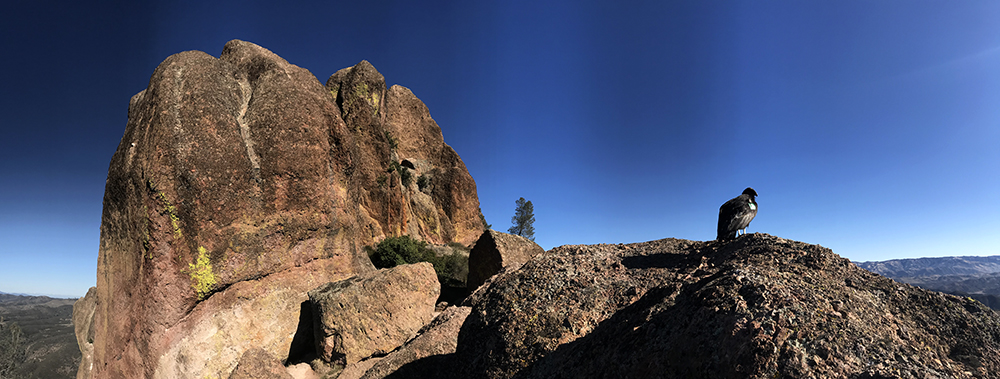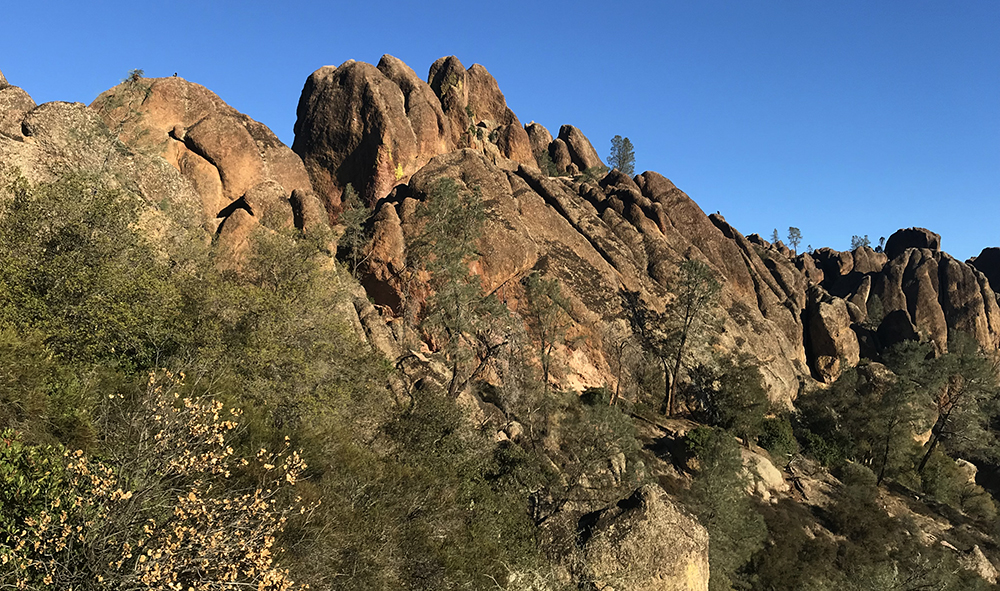Pinnacles National Park is a scenic land of spires, cliffs and rooks, nestled quietly in the relatively unknown Gabilan Mountains of Central California.

Guide to Pinnacles
Pinnacles National Park
This is a young member of the national park club, gaining the status in January of 2013 passage by Congress and the signature of President Barack Obama. Although it is a youthful park, it has long enjoyed protection, as it was first named a national monument by our man TR in 1908.
Exploring Pinnacles
Pinnacles is a small park, especially by western standards, weighing in at a mere 133,000 acres and boasting a lowly 32 miles of hiking trail. Rest assured however, that what this park may lack in size and mileage, it more than makes up for in the delivery of incredible scenery and winding trails that boogie woogie on your brain…
Despite its smaller size, this is a wilderness park due in part to the fact that no roads pass through it. Entrances to the east and west sections of the park take motorists only so far into the park. While nice views are available from roadside stops and picnic areas, to experience the pinnacles up close, a backcountry hike is in order. Trailheads exist on both sides of the park, and lead quickly into the cliffs, or into canyons lush with vegetation.

Playtime
Visitors here can get a workout through a combination of activities including hiking, caving and rock climbing.
As far as hiking goes, It’s no exaggeration to suggest that the High Peaks Trail leads hikers through the most exciting and scenic sections of this park. This trail requires a commitment to a hike of a minimum of 7 miles with an elevation gain of at least 1,400 feet. There are some areas of this trail where those with a fear of heights may have concern.

Numerous loop options exist along this trail, depending on whether hikers begin from the east or west side of the park. This trail has great views and winds through the upper pinnacles and provides panoramas of both the east and western surrounding lands. Several sections of the trail are equipped with handrails, as there is a fair amount of exposure in certain areas and footsteps have been carved into the rock by the CCC in order to facilitate better footing. Simply an awesome trail.
This park can be hiked out by the eager hiker in a couple of days, as most of the trails are concentrated around the High Peaks area, but the 9 mile round-trip trail to Chalone Peak, the park’s highest peak, is fun and offers something a bit removed from the center of the park. See the activities page for a complete list of the hiking options in Pinnacles.
“Caves”
The trails in this park offer a variety of terrain and include a couple of “cave” trails. Although true cavers (I’m told that the term spelunking is frowned upon these days) may scoff at the notion of these tunnels being referred to as caves, most visitors will find them worthy of leisurely exploration.

The Balconies Cave and the Bear Gulch Cave are simply narrow canyons into which falling rocks have been lodged. After numerous rocks fall into the passageways and pile atop previously fallen boulders of significant size, a sort of cave is formed.
These areas are indeed dark and require the use of a headlamp or other light emitting device. The Balconies Cave Trail was quite simply, fantastically fun and lies in a scenic canyon wonderland of green and red and blue hues with pinkish cliffs rising above.
Rock Climbing in Pinnacles
Rock climbing here is popular, but the rock is nowhere near the same quality that local dirtbags may be accustomed to in nearby parks such as Yosemite or Kings/Sequoia. This rock is a strange volcanic breccia, which translates to “chossy” in some strange language that Park Junkie struggles to speak. Climbing routes are abundant here, with more than 800 routes detailed by a couple of guide books that are available.
Discovery Rock, on the eastern side of the park, is the most popular climbing area, so it may be the safest, as this breccia rock is known to break of when you really don’t want it to… So the more action an area receives, the safer it should be, theoretically at least. Keep in mind, that climbing is prohibited above established hiking trails. Check with the visitor center to determine if other areas may be closed for nesting birds or other reasons.

The eastern section of the park is the more popular of the two, and has a visitor’s center and the park’s only campground, which is the only park campground to provide a swimming pool, which is a welcomed addition during the hot, dry months of summer, during which temperatures can often top 100 degrees.
Geology
The origins of the park’s namesake are remnants of a number of ancient volcanoes that erupted an estimated 23 million years ago. Interestingly, these eruptions were located some 195 miles south of the current location of the park, near modern day Lancaster, California and scientists report that the mountains are indeed still on the move, inching northward toward the Bay Area at the rate of about 2 inches per year. Soon enough, those of you in San Francisco will enjoy a shorter commute to this gem of a park.
Condors
The park is home to the fabled California Condor. These graceful pilots with wingspans nearing 10 feet in width live more than 50 years and can regularly be observed in the spring, soaring effortlessly above the mountains in a majestic display of power and prowess that leaves hikers straining necks in effort to witness such a rare sight. Those who sit patiently on the cliffs along the High Peaks Trail are almost certain to see the creatures.

But be aware! These birds indeed appear unafraid of us mere mortals and may very well cruise right on in for a personal introduction that may leave casual visitors stammering in disbelief. Watch your footing during such moments and be aware of your surroundings, you are on a pinnacle, after all… & please, don’t act a fool and try to feed the damn things!
These vulturous fowl of the air dine on carrion, (dead stuff). Feeding them likely leads them to associate you with food, not long after which, they may very well push YOU over a cliff, knowing that your carcass will begin to rot in a just a few days…
“Sometimes you eat the bear, and sometimes, the bear, why, he eats you…”
Park Junkie Verdict
Pinnacles is a fun park that can be enjoyed thoroughly in a couple of days. The trails seem quiet given the location. The park offers relatively quick access to a wild land that has really bizarre scenery and the High Peaks Trail is a favorite hiking adventure for sure.
Combine these attributes with crazy huge birds that welcome you like someone having an old friend for dinner, (don’t trust them & keep your distance) and you have a fave park junkie quickie here…
See ya there…
Guide to Pinnacles
Relevant Links
National Park Guides

All content found on Park Junkie is meant solely for entertainment purposes and is the copyrighted property of Park Junkie Productions. Unauthorized reproduction is prohibited without the express written consent of Park Junkie Productions.
YOU CAN DIE. Activities pursued within National Park boundaries hold inherent dangers. You are solely responsible for your safety in the outdoors. Park Junkie accepts no responsibility for actions that result in inconveniences, injury or death.
This site is not affiliated with the National Park Service, or any particular park.
